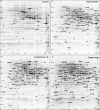Changes in the proteome of Candida albicans in response to azole, polyene, and echinocandin antifungal agents
- PMID: 20145080
- PMCID: PMC2863685
- DOI: 10.1128/AAC.00756-09
Changes in the proteome of Candida albicans in response to azole, polyene, and echinocandin antifungal agents
Abstract
The yeast Candida albicans is an opportunistic human fungal pathogen and the cause of superficial and systemic infections in immunocompromised patients. The classes of antifungal agents most commonly used to treat Candida infections are the azoles, polyenes, and echinocandins. In the present study, we identified changes in C. albicans protein abundance using two-dimensional polyacrylamide gel electrophoresis and matrix-assisted laser desorption ionization-time of flight mass spectroscopy following exposure to representatives of the azole (ketoconazole), polyene (amphotericin B), and echinocandin (caspofungin) antifungals in an effort to elucidate the adaptive responses to these classes of antifungal agents. We identified 39 proteins whose abundance changed in response to ketoconazole exposure. Some of these proteins are involved in ergosterol biosynthesis and are associated with azole resistance. Exposure to amphotericin B altered the abundance of 43 proteins, including those associated with oxidative stress and osmotic tolerance. We identified 50 proteins whose abundance changed after exposure to caspofungin, including enzymes involved in cell wall biosynthesis and integrity, as well as the regulator of beta-1,3-glucan synthase activity, Rho1p. Exposure to caspofungin also increased the abundance of the proteins involved in oxidative and osmotic stress. The common adaptive responses shared by all three antifungal agents included proteins involved in carbohydrate metabolism. Some of these antifungal-responsive proteins may represent potential targets for the development of novel therapeutics that could enhance the antifungal activities of these drugs.
Figures
Similar articles
-
Genome-wide expression profiling of the response to azole, polyene, echinocandin, and pyrimidine antifungal agents in Candida albicans.Antimicrob Agents Chemother. 2005 Jun;49(6):2226-36. doi: 10.1128/AAC.49.6.2226-2236.2005. Antimicrob Agents Chemother. 2005. PMID: 15917516 Free PMC article.
-
Emodin Reduces the Activity of (1,3)-β-D-glucan Synthase from Candida albicans and Does Not Interact with Caspofungin.Pol J Microbiol. 2018;67(4):463-470. doi: 10.21307/pjm-2018-054. Pol J Microbiol. 2018. PMID: 30550232 Free PMC article.
-
Impact of brief exposure to antifungal agents on the post-antifungal effect and hemolysin activity of oral Candida albicans.J Appl Oral Sci. 2015 Jul-Aug;23(4):412-8. doi: 10.1590/1678-775720150100. J Appl Oral Sci. 2015. PMID: 26398514 Free PMC article.
-
Mechanisms of echinocandin antifungal drug resistance.Ann N Y Acad Sci. 2015 Sep;1354(1):1-11. doi: 10.1111/nyas.12831. Epub 2015 Jul 17. Ann N Y Acad Sci. 2015. PMID: 26190298 Free PMC article. Review.
-
Candida and candidaemia. Susceptibility and epidemiology.Dan Med J. 2013 Nov;60(11):B4698. Dan Med J. 2013. PMID: 24192246 Review.
Cited by
-
From Yeast to Humans: Leveraging New Approaches in Yeast to Accelerate Discovery of Therapeutic Targets for Synucleinopathies.Methods Mol Biol. 2019;2049:419-444. doi: 10.1007/978-1-4939-9736-7_24. Methods Mol Biol. 2019. PMID: 31602625
-
Proteomic Analysis of Caspofungin-Induced Responses in Planktonic Cells and Biofilms of Candida albicans.Front Microbiol. 2021 Feb 18;12:639123. doi: 10.3389/fmicb.2021.639123. eCollection 2021. Front Microbiol. 2021. PMID: 33679674 Free PMC article.
-
Transcriptional Regulation on Aneuploid Chromosomes in Divers Candida albicans Mutants.Sci Rep. 2018 Jan 26;8(1):1630. doi: 10.1038/s41598-018-20106-9. Sci Rep. 2018. PMID: 29374238 Free PMC article.
-
Neurospora crassa transcriptomics reveals oxidative stress and plasma membrane homeostasis biology genes as key targets in response to chitosan.Mol Biosyst. 2016 Feb;12(2):391-403. doi: 10.1039/c5mb00649j. Mol Biosyst. 2016. PMID: 26694141 Free PMC article.
-
Molecular and cellular responses of the pathogenic fungus Lomentospora prolificans to the antifungal drug voriconazole.PLoS One. 2017 Mar 31;12(3):e0174885. doi: 10.1371/journal.pone.0174885. eCollection 2017. PLoS One. 2017. PMID: 28362854 Free PMC article.
References
-
- Akins, R. A. 2005. An update on antifungal targets and mechanisms of resistance in Candida albicans. Med. Mycol. 43:285-318. - PubMed
-
- Arning, M., K. O. Kliche, A. H. Heer-Sonderhoff, and A. Wehmeier. 1995. Infusion-related toxicity of three different amphotericin B formulations and its relation to cytokine plasma levels. Mycoses 38:459-465. - PubMed
-
- Bates, D. W., L. Su, D. T. Yu, G. M. Chertow, D. L. Seger, D. R. Gomes, and R. Platt. 2001. Correlates of acute renal failure in patients receiving parenteral amphotericin B. Kidney Int. 60:1452-1459. - PubMed
-
- Braun, B. R., M. van Het Hoog, C. d'Enfert, M. Martchenko, J. Dungan, A. Kuo, D. O. Inglis, M. A. Uhl, H. Hogues, M. Berriman, M. Lorenz, A. Levitin, U. Oberholzer, C. Bachewich, D. Harcus, A. Marcil, D. Dignard, T. Iouk, R. Zito, L. Frangeul, F. Tekaia, K. Rutherford, E. Wang, C. A. Munro, S. Bates, N. A. Gow, L. L. Hoyer, G. Kohler, J. Morschhauser, G. Newport, S. Znaidi, M. Raymond, B. Turcotte, G. Sherlock, M. Costanzo, J. Ihmels, J. Berman, D. Sanglard, N. Agabian, A. P. Mitchell, A. D. Johnson, M. Whiteway, and A. Nantel. 2005. A human-curated annotation of the Candida albicans genome. PLoS Genet. 1:36-57. - PMC - PubMed
-
- Bruneau, J. M., I. Maillet, E. Tagat, R. Legrand, F. Supatto, C. Fudali, J. P. Caer, V. Labas, D. Lecaque, and J. Hodgson. 2003. Drug induced proteome changes in Candida albicans: comparison of the effect of beta (1,3) glucan synthase inhibitors and two triazoles, fluconazole and itraconazole. Proteomics 3:325-336. - PubMed
Publication types
MeSH terms
Substances
Grants and funding
LinkOut - more resources
Full Text Sources
Medical


